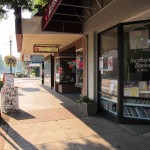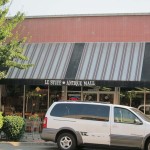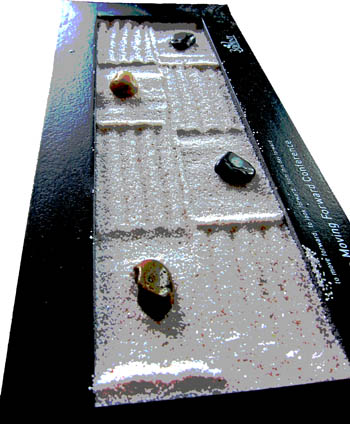
If I were supernatural, I might choose to be an awning fairy. My mission? Roaming the land, eradicating horrible awnings with the touch of my sparkly magic wand. (By roaming, I mean that I would be flying, of course.)
Sadly, I am coming around to the fact that I won’t be manifesting any special powers in the near future. But, I have not let the dream die entirely. No, I try to do the work of the awning fairy without extraordinary skills. In my war against underperforming mixed-use districts, I do battle with over-awninged places using just my voice, a whole lotta pictures, and field trips.
LEVERAGING HISTORIC DOWNTOWN ENVIRONMENTS
To maximize the economic return on historic infrastructure, it must be highlighted in every possible way, particularly for pedestrians. These renovated buildings in Tacoma, Washington, pictured to the left, are a good example. A visitor on the sidewalk should experience the grandeur and unique character of the building stock when looking down the same side of the street on which they stand, or when gazing across the road.
Interconnected and unique buildings are a huge part of what creates a great ambiance in a downtown or Main Street environment.
In a struggling mixed-use district, there are myriad examples of not leveraging historic infrastructure properly. But today, I want to focus on one particular culprit—the awning, something that is often invisible to stakeholders and which can be particularly difficult to eradicate. In a downtown that lacks vitality, it is very common to view a plethora of awnings that are inappropriate architecturally…a sea of moldy awnings…tons of tattered awnings…and awnings that are so large they take up one third to one half of the vertical face of the building.
In the photos below (please click to enlarge), you can see that instead of this district differentiating itself through its superior historic infrastructure, it has instead been turned into a sort of umbrella corridor, where the sidewalk experience is one highlighting unattractive awnings and the metal infrastructure used to hold them up. Or, the awnings block building and storefront visibility from across the street.





DOWNTOWN DISTRICTS WILL NEVER PROVIDE “RAIN FREE” SHOPPING EXPERIENCES
“But what about the rain, Michele?”
I hear this a lot. And okay, I grant you, many of the communities I work with are in the Pacific Northwest. But really, at the end of the day, no one is making a decision about where to shop based upon whether or not a building has an awning.
This desire to create a rain-free shopping environment is a vestige of the postwar abandonment of downtowns and mixed-use districts for the mall. And, it doesn’t work.
An economically successful downtown has striking buildings and vibrant, engaging storefronts with well lit window displays. It should be an environment that entices visitors to stay, to shop, to grab a cup of coffee, to want to discover what is around the next corner. Any shopper that comes to one particular store, becomes a potential shopper for every other store. The pedestrian is king and they are what drive sales per square foot. These browsers have to go to and from their car. They have to cross the street. They cannot be protected from the rain every single moment they are in a downtown district. So don’t even try to provide this service.
The question I always ask property owners and business owners is this: “If a potential shopper is standing across the street from your building, will they make the journey through traffic to walk to your store?” I want to know if they see anything compelling, because a true test of a district’s health is a walker’s willingness to cross the street to sample wares on the other side of the road.
As these owners contemplate their buildings and businesses (I like to do this literally standing outside, gazing at their property), I follow up with these inquiries, “Do shoppers think, ‘Hey, there’s an awning over there, and it’s huge, so I’m going to go to that store!’ Or, is what really grabs their attention the quality of the building, the visibility and attractiveness of the storefront, and how well the products are merchandised?”
FORM SHOULD FOLLOW FUNCTION—AWNINGS THAT CONTRIBUTE TO ECONOMIC SUCCESS
In a district where all of the buildings have had awnings forever, it is very difficult to get people to change their approach to building and storefront design. They tend to assume the awning will be kept and that all decisions related to appearance will stem from there. This is designing from the awning inward. Instead, owners should be designing from the building/store outward. First, make the building as appealing as possible. Second, draw attention to the storefront and merchandise. Third, come up with an attractive sign and lighting scheme. Then and only then should you contemplate an awning. I can’t tell you how often I have to stress that an awning is an accessory, not the main attraction, and it should be considered last in the design process, not first.
My general rule of thumb is that awnings are useful when they:
- Do not dominate the vertical facade of a building; and
- Are defining an outdoor room that is an extension of the storefront, bringing the business out to the sidewalk, engaging pedestrians in street level dialog.
But remember, awnings are difficult to light appropriately, often detract from building appeal, invariably block transom windows, and create dark caves that decrease storefront visibility. So, unless a business is going to aggressively make the area under their awning part of their store or restaurant, then lose it. Just forget about it.
Good examples of awnings that create positive, engaging ground floor environments are shown in the photographs below (please click to enlarge).





A final note on the role of the public sector in regards to awnings: cities should not be in the business of requiring awnings, especially as they are often temporary finishes on existing buildings. Making structures host an awning unnecessarily constrains architectural design for new buildings and puts a huge burden on existing buildings, which must shoulder these appendages even when they literally have no use. Stipulating awnings also has the unintended consequence of ensuring that there will be a plethora of canopies in poor condition because those who don’t really want an awning will refuse to incur the expense of replacing it, so tired old awnings will become the norm.











